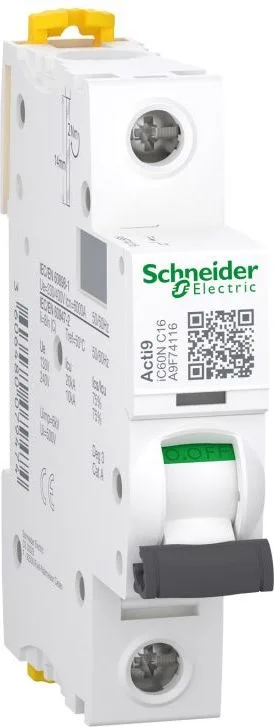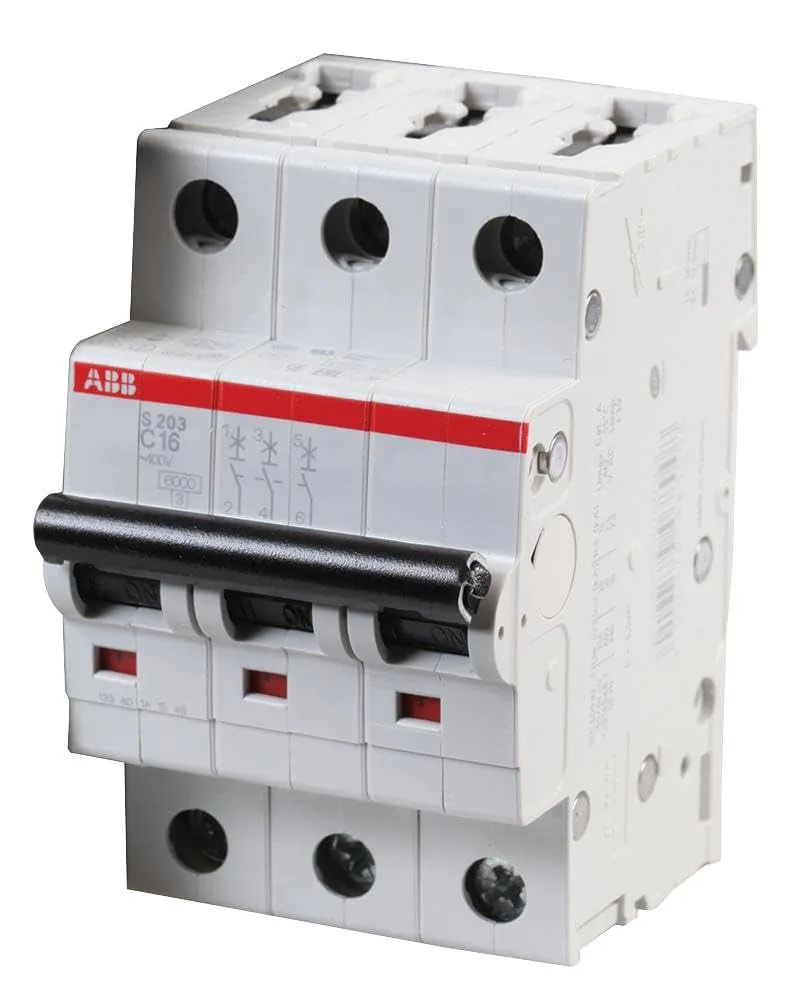Reading an MCB nameplate correctly is essential for electrical safety, proper installation, and code compliance. The nameplate contains critical information about current rating, breaking capacity, voltage rating, and safety classifications that determine whether the breaker is suitable for your specific application.
Understanding how to interpret every symbol, number, and marking on a miniature circuit breaker nameplate can prevent electrical hazards, ensure code compliance, and help you select the right protection device for your electrical system.
What is an MCB Nameplate and Why Does It Matter?
A miniature circuit breaker nameplate is a standardized label that displays essential technical specifications, safety ratings, and compliance information required by international electrical standards (IEC 60898, UL 489, and local electrical codes).
⚠️ Предупреждение о безопасности: Never install or use an MCB without understanding its nameplate specifications. Incorrect installation can result in fire hazards, equipment damage, or electrical shock.
The nameplate serves three critical functions:
- Safety assurance through proper rating verification
- Соответствие Кодексу by meeting electrical standard requirements
- System protection by ensuring correct breaker selection
Key Nameplate Components: Complete Breakdown
Here is a table that shows the essential elements found on every MCB nameplate:
| Компонент | Назначение | Пример | Critical Notes |
|---|---|---|---|
| Текущий рейтинг | Максимальный постоянный ток | 16A, 20A, 32A | Must not exceed circuit demand |
| Номинальное напряжение | Maximum operating voltage | 230V, 400V | Должно соответствовать или превышать напряжение системы |
| Разрывная способность | Maximum fault current it can interrupt | 6kA, 10kA | Must exceed system fault levels |
| Тип кривой | Trip characteristic curve | B, C, D | Determines sensitivity to overloads |
| Standard Marking | Compliance certification | IEC 60898, UL 489 | Required for code compliance |
| Manufacturer Info | Brand and model identification | VIOX | Essential for replacements |
Step-by-Step Guide: How to Read MCB Nameplates
Step 1: Locate and Examine the Nameplate
The nameplate is typically located on the front face or side of the MCB housing. Ensure proper lighting and use a flashlight if necessary to read small text clearly.
Step 2: Identify the Current Rating
Look for: A number followed by “A” (amperes)
Examples: 6A, 10A, 16A, 20A, 25A, 32A, 40A, 50A, 63A
What it means: Maximum continuous current the breaker can carry without tripping
💡 Совет эксперта: The current rating must be at least 125% of the continuous load current per NEC requirements.
Step 3: Verify the Voltage Rating
Look for: Numbers followed by “V” or “VAC”
Common ratings: 120V, 230V, 400V, 480V
Critical note: The voltage rating must meet or exceed your system’s operating voltage
Step 4: Check the Breaking Capacity
Look for: Numbers followed by “kA” (kiloamperes)
Common values: 3kA, 6kA, 10kA, 15kA, 25kA
What it means: Maximum fault current the breaker can safely interrupt
Step 5: Identify the Trip Curve Type
Look for: Letters B, C, or D
- Тип B: 3-5 times rated current (lighting circuits)
- Type C: 5-10 times rated current (general purpose, motors)
- Type D: 10-20 times rated current (high inrush loads)
Step 6: Verify Standards Compliance
Look for: IEC 60898, UL 489, CSA, or local standard markings
Why it matters: Ensures the breaker meets electrical code requirements
Advanced Nameplate Information
Auxiliary Contact Ratings
Many MCBs include auxiliary contact specifications for remote monitoring or control applications.
Typical markings:
– Contact rating: 6A/250VAC
– Number of contacts: 1NO (normally open) or 1NC (normally closed)
Environmental Classifications
Look for these additional markings:
| Marking | Значение | Приложение |
|---|---|---|
| IP20 | Standard indoor protection | Только для сухих мест |
| от -25°C до +70°C | Диапазон рабочих температур | Environmental suitability |
| Altitude rating | Maximum installation height | High-altitude applications |
Common MCB Nameplate Configurations
Single-Pole MCB Nameplate Example
SCHNEIDER ELECTRIC iC60N C16 230/400V~ 6000A IEC 60898-1 Icn=6kA Icu=6kA
Translation:
– Manufacturer: Schneider Electric
– Model: iC60N with C-curve, 16A rating
– Voltage: 230V phase-to-neutral, 400V phase-to-phase
– Breaking capacity: 6kA
– Standard: IEC 60898-1 compliant
Three-Pole MCB Nameplate Example
ABB S203 C16 400V~ Icn=6000A 3P IEC 60898-1
Translation:
– Manufacturer: ABB
– Model: S203 series
– Rating: C-curve, 16A, 400V three-phase
– Breaking capacity: 6kA
– Configuration: 3-pole
MCB Selection Based on Nameplate Information
Current Rating Selection Guide
Шаг 1: Рассчитайте ток нагрузки
– Measure or calculate the actual current draw
– Add 25% safety margin per electrical codes
Шаг 2: Select appropriate MCB rating
– Choose the next standard rating above your calculated requirement
– Common ratings: 6A, 10A, 16A, 20A, 25A, 32A, 40A, 50A, 63A
Требования к отключающей способности
Here is a table that shows minimum breaking capacity requirements:
| Тип приложения | Minimum Icn Rating | Typical Systems |
|---|---|---|
| Жилой | 3-6kA | Single-phase homes |
| Коммерческая | 6-10kA | Small businesses, offices |
| Рабочая обувь | 10-25kA | Manufacturing, large facilities |
| Utility-tied | 15-50kA | Grid connections, substations |
Вопросы безопасности и соответствия нормам
Критические требования безопасности
⚠️ Внимание: Always verify these safety criteria before installation:
- Совместимость с текущими рейтингами with circuit protection requirements
- Адекватность номинального напряжения for system voltage levels
- Breaking capacity sufficiency for available fault current
- Environmental suitability for installation location
- Соблюдение стандартов with local electrical codes
Требования к профессиональной установке
When to call a professional:
– Commercial or industrial installations
– Systems above 50A current rating
– High breaking capacity requirements (>10kA)
– Code compliance verification needed
Troubleshooting Common Nameplate Reading Issues
Problem: Nameplate Text is Faded or Unreadable
Решение:
– Use bright LED flashlight or magnifying glass
– Clean nameplate surface with dry cloth
– Cross-reference with manufacturer documentation
– Replace MCB if nameplate is completely illegible
Problem: Multiple Voltage Ratings Listed
Explanation: Many MCBs are rated for multiple voltage configurations
Пример: 230/400V means 230V phase-to-neutral OR 400V phase-to-phase
Действие: Select the rating that matches your system configuration
Problem: Conflicting Standard Markings
Причина: Some MCBs carry multiple certifications (IEC, UL, CSA)
Решение: Ensure the breaker meets your local electrical code requirements
Рекомендация: Consult with local electrical inspector if uncertain
Советы по выбору экспертов
💡 Professional Recommendations:
- Always choose higher breaking capacity when in doubt – it provides additional safety margin
- Match curve types to load characteristics – Use Type C for general applications
- Consider future load growth when selecting current ratings
- Verify compatibility with existing electrical panel manufacturer
- Document all nameplate information for maintenance records
Quick Reference: MCB Nameplate Checklist
Pre-Installation Verification:
- [ ] Current rating ≥ 125% of load current
- [ ] Voltage rating ≥ system voltage
- [ ] Breaking capacity ≥ available fault current
- [ ] Appropriate curve type for load
- [ ] Standards compliance verified
- [ ] Environmental rating suitable
- [ ] Manufacturer compatibility confirmed
Вопросы и ответы
What happens if I use an MCB with insufficient current rating?
Using an undersized MCB will cause nuisance tripping, reducing system reliability and potentially creating safety hazards through repeated thermal cycling.
Can I use an MCB with higher breaking capacity than required?
Yes, using higher breaking capacity provides additional safety margin and is always acceptable. However, it may increase initial cost.
What does the tilde (~) symbol mean on MCB nameplates?
The tilde (~) indicates alternating current (AC) rating, distinguishing it from direct current (DC) applications which use different symbols.
How do I verify if an MCB meets my local electrical code?
Check for appropriate standard markings (UL 489 for US, IEC 60898 for international) and consult your local electrical inspector or authority having jurisdiction.
What should I do if the nameplate shows multiple current ratings?
Multiple ratings typically indicate different configurations (single-pole vs. multi-pole). Use the rating that corresponds to your specific installation configuration.
Can I replace an MCB with a different brand if the ratings match?
While ratings may match, ensure mechanical compatibility with your electrical panel and verify that both MCBs meet the same standards for code compliance.
What does “Icn” vs “Icu” mean on MCB nameplates?
– Icn: Service breaking capacity (normal duty)
– Icu: Ultimate breaking capacity (maximum interrupting capability)
Use Icn for standard applications and Icu for extreme fault current scenarios.
How often should MCB nameplates be inspected?
Inspect nameplates during routine electrical maintenance (annually for commercial, every 3-5 years for residential) or whenever questions arise about breaker suitability.
—
Профессиональная рекомендация: When in doubt about MCB nameplate interpretation or application suitability, consult with a qualified electrician or electrical engineer. Proper breaker selection is critical for electrical safety and code compliance.
Следующие шаги: Use this nameplate information to verify your current MCB installations and ensure they meet safety requirements and electrical codes. Keep this guide readily available for future electrical maintenance and upgrade projects.






